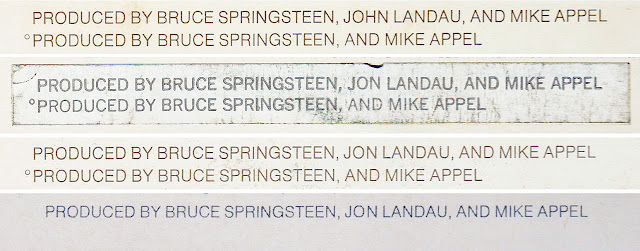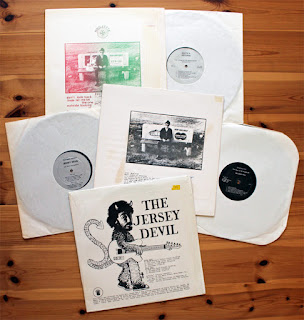The album sleeve variations, counting from the "Script Cover" test pressing to the most recent 2014 remastered LP, are classified into 10 releases (simply designated RELEASES 1 to 10) by my personal view. The following list is not necessarily complete, may miss a few or more variant issues of which I am not aware, and may contain some errors and misunderstandings.
 |
| Who's idea is this? Closing up "Script"-shaped title. |
No need to explain this, and if still needed, among many others, a blog article here. No track information, no lyrics, no credits, no words, letters and numbers printed on the sepia-toned black and white picture gate-fold sleeve, except for the album title and artist name in calligraphic type.
RELEASE 2: The early pressing with a spelling error (PC 33795)
Most notably known for "John," a misspelling of co-producer Jon Landau's name. The producers for the title track (i.e. Bruce Springsteen and Mike Appel) and those for the rest seven tracks (i.e., Springsteen, Landau, and Appel) are credited together on the bottom center of the rear sleeve. No bar code is printed on the sleeve throughout this catalog number (prefix "PC" issues). On the bottom of the spine is found "X698" which refers to the designated list price for this LP edition (i.e., $6.98). Originally, "PC" prefix of Columbia's catalog numbering system means a list price of $5.98, which probably explains why "X698" is printed on the spine.
RELEASE 3: The early pressing with the error-corrected sticker (PC 33795)
There are not any differences between this and RELEASE 2 except that the error-fixed sticker, which corrects "John" to "Jon", masks the entire album producers credits originally printed on the sleeve. It is of note that most of the spelling-error copies in circulation are in fact once pasted a sticker before released to market but peeled it off after purchased, which is easily recognized by checking traces where the sticker was pasted. The area is often discolored and/or dirty due to glue splotch or chemical treatments to remove the sticker. So, my guess is that the "intact" erroneous copies, that have escaped the correction and never been modified with stickers, are rather rare.
RELEASE 4: The early pressing without spelling errors (PC 33795)
"John" misspelling is fixed and all the rest is the same as RELEASES 2 and 3. I've seen most of the white label copies come with this version of the gate-fold sleeve (often with the D.J. timing strip on front and promo stamp on back). One copy in my collection has a printing error where a small round annotation mark (i.e. oBORN TO RUN) is missing from the title track information. According to the matrix inscriptions on the wax, this copy seems to have been manufactured at the Santa Maria pressing plant in California. Assuming that this is true, I still have no idea whether this small error is found only in small fractions of the copies including mine or generally occurs in the copies from this pressing plant.
RELEASE 5: The mid pressing (PC 33795)
Substantial revision is made on album credits compared with the previous editions. The producers' credits on the title track ("Produced by Bruce Springsteen, and Mike Appel") is now separated from the other credit ("Produced by Bruce Springsteen, John Landau, and Mike Appel") and moved to the corresponding track information column, which gives a faulty impression as if J. Landau were involved in the production of the entire album tracks. For the first time credited are the horns' arrangement (by Steve Van Zandt and Bruce Springsteen) on Tenth Avenue Freeze-Out and the violin performed (by Suki Lahav) on Jungleland. The album engineer is also newly added on the bottom part of the rear sleeve ("Engineered by Jimmy Iovine") although this credit already appears on the inside of the gate-fold sleeve for the earlier versions. This variant category includes both faulty manufactured gate-fold sleeve and Japan-export modified sleeve copies that have been reported on this blog.
There is a minor change from RELEASE 5 that removes "X698" from the spine, most probably reflecting the list price revision (to $7.98). One copy in my collection has a small clear sticker with black "JC 33795" stamp that is overlaid on the "PC" code on the spine, which is another indication of list price change.
RELEASE 7: The reissue pressing (JC 33795)
Accompanying the revision of the catalog number prefix from "PC" to "JC" (which means list price change) is the introduction of a bar code that is printed on the upper right corner of the rear sleeve. The catalog number, that is printed above the Columbia logo of the "PC" sleeves, is now deleted on this "JC" sleeve. This reissue category includes unusual red label copies. Some pressings have a silver sticker on front advertising that this album is also available as a Half-Speed Mastered edition.
RELEASE 8: The Half-Speed Mastered reissue pressing (HC 33795 / HC 43795)
This audiophile pressing has basically the same sleeve design as that of RELEASE 7 except that (1) the two blue "Half-Speed Mastering" logos appear on the front sleeve; (2) the Columbia logo is moved from upper-right to bottom-left corner on the rear sleeve; (3) two additional sentences regarding this special pressing are added on top and bottom of the rear sleeve (i.e THIS RECORD IS ... and "Mastersound" and ..., respectively); and (4) The spine has different writings "COLUMBIA HALF-SPEED MASTERED" on the bottom, instead of "COLUMBIA STEREO". The 10-digt number, 7464-33795-0, printed below the bar code is slightly different from that of RELEASE 7 (7464-33795-1). The Half-Speed Mastered series have been released in 1981 originally and reissued in 1982 under the different catalog number (HC 43795; The bar code number is 7464-43795-1). I don't own the latter but assume that there are no substantial differences between initial and second copies. The test pressing for this "upgrade" reissue has been in circulation at collectors' market. My copy comes in a white plain sleeve on the upper left corner of which the matrix numbers are hand-written in indigo (HAL-33795-2B and HBL-33795-2A). The record labels are white Pitman Pressing Plant labels for test pressing.
RELEASE 9: The Classic Records reissue pressing (PC 33795 / PC 33795-22 GM)
Another audiophile pressing has no major changes in sleeve design but the Columbia logo and bar code are now deleted on the rear sleeve. According to the Lost In The Flood collector's page, this heavy vinyl is originally released in 1999 and reissued in 2005 (PC 33795-22 GM), but I don't have a reissue copy for making comparison.
RELEASE 10: The Remastered reissue pressing (PC 33795) from THE ALBUM COLLECTION VOL. 1, 1973-1984 (US Columbia 88875 01415 14)
My box is still shrink-wrapped and so I can't check the sleeve. However, the images available through online and several "Unboxing" videos uploaded on YouTube indicate that the rear sleeve credits for the remastered vinyl looks most resemble those of RELEASE 5, thus not reproducing the original sleeve in strict sense.
Again, I don't mean that the above list is complete, and corrections and additions are always welcome. The more one would examine available copies carefully and thoroughly, the more variations and differences would be revealed. As you can see, for example, minor differences are already noticeable in some images shown here with respect to font color/size/thickness and picture tone/contrast on the sleeves among these variants (which is especially notable between "PC" and the other releases). Here I disregard all these kinds of variations, though.
→ Check here for the updated information.



















